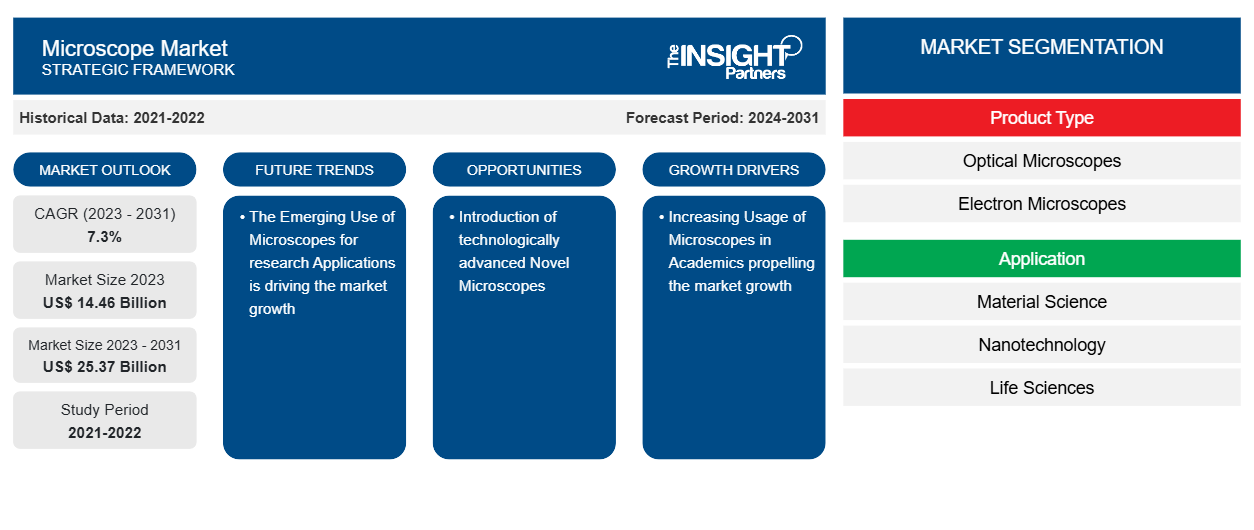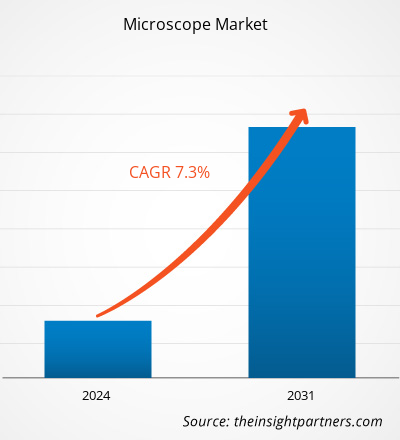The microscope market size is projected to reach US$ 4,034.79 million by 2031 from US$ 2,657.70 million in 2024. The market is estimated to register a CAGR of 6.20% during 2025–2031. The increasing integration of AI and remote technologies in the microscope are likely to bring new trends to the market in the coming years.
Microscope Market Analysis
The increasing applications of research and healthcare, and the growing funding in research and development, accelerate the market growth. Research and healthcare applications propel the demand for advanced and specialized microscopy solutions. Microscopes play a crucial role in enabling researchers to observe and analyze biological specimens at the cellular and molecular level. For instance, in cancer research, high-resolution microscopy techniques such as confocal and fluorescence microscopy are extensively used to study tumor morphology, cellular behavior, and molecular interactions for the development of targeted therapies. Microscopy is essential in pathology and diagnostics, particularly for examining blood samples, tissue biopsies, and infectious agents. The growing prevalence of chronic diseases such as diabetes and cancer, as well as infectious diseases such as tuberculosis, has created the need for accurate diagnostic tools. For instance, digital pathology microscopes equipped with AI-powered image analysis are increasingly being adopted in hospitals to improve diagnostic accuracy and workflow efficiency.
Various product launches have taken place in the microscope market. For instance, in May 2025, Evident announced the release of two new spinning disk confocal microscopes, the IXplore IX85 SpinXL and the IXplore IX85 SpinSR. Built on Evident’s new IXplore IX85 automated inverted microscope system, the IX85 SpinXL and IX85 SpinSR add powerful new technology to the platform, expanding the possibilities of what researchers can capture and discover in live-cell imaging.
Microscope Market Overview
Microscopy is critical in medical education and training, enabling students and professionals to develop practical skills and a deeper understanding of human anatomy and pathology. Educational institutions are investing in interactive and digital microscopy platforms that allow virtual microscopy and remote learning. Moreover, microscopes are crucial in veterinary medicine, environmental science, and agricultural research to monitor animal health, detect environmental contaminants, and improve crop yields. For instance, electron microscopy is widely used in plant pathology to study viruses and fungi affecting crops, facilitating the development of disease-resistant plant varieties. Therefore, the expanding scope of research and healthcare applications, coupled with technological advancements in microscopy, drives the growth of the microscope market.
Customize This Report To Suit Your Requirement
You will get customization on any report - free of charge - including parts of this report, or country-level analysis, Excel Data pack, as well as avail great offers and discounts for start-ups & universities
Microscope Market: Strategic Insights

-
Get Top Key Market Trends of this report.This FREE sample will include data analysis, ranging from market trends to estimates and forecasts.
Microscope Market Drivers and Opportunities
Surging Research Funding Bolsters the Market Growth
The European Union’s Horizon Europe program, which has a budget exceeding US$ 107.94 (Euro 93.5) billion for 2021–2027, supports a wide range of scientific initiatives. Such massive investments contribute directly to the growing microscope market as the institutions invest in modern devices to fulfill their research goals. Moreover, private sector investments, including pharmaceutical companies and biotech startups, are contributing to the rising demand for microscopes. For instance, drug discoveries rely on fluorescence and electron microscopy to visualize drug-target interactions at the cellular level. According to the International Federation of Pharmaceutical Manufacturers and Associations, global pharmaceutical research and development spending reached US$ 276 billion in 2021, with a sizable share dedicated to research utilizing microscopy technologies. Therefore, an increase in research funding enables scientific institutions to acquire and upgrade advanced microscopy equipment and boosts the microscope market growth.
Increasing Product Launches by Market Players to Create Opportunities
The presence of various market players in microscope market focuses on product launches that help in the diagnosis, observation, and other applications in the life science industry. Various product launches have taken place in the microscope market. A few of them are mentioned below:
- In November 2024, Evident launched the IXplore IX85 automated inverted microscope system. Featuring a 26.5mm field number (FN), combined with new advanced imaging tools to ensure accurate and clear results, this new system allows researchers to capture more data and discover new insights faster than ever. It also provides an unmatched level of customizability, allowing users to design or build a high-performance imaging and intelligent platform that meets their requirements.
- In September 2024, Nikon launched the ECLIPSE Ui Ver. 1.3 digital imaging microscope for medical use, and is equipped with three new functions that contribute to streamlining pathological observation and preventing lesion sites from being overlooked.
Microscope Market Report Segmentation Analysis
Key segments that contributed to the derivation of the microscope market analysis are technology, end user, and geography.
- Based on technology, the microscope market is segmented into optical microscope, electron microscope, scanning probe microscope, and others. The optical microscope segment held the largest share of the microscope market in 2024, and it is expected to register a significant CAGR during 2025–2031.
- In terms of end user, the microscope market is segmented into academics and research institutes, pharmaceuticals and biopharmaceutical companies, diagnostic centers, and others. The pharmaceuticals and biopharmaceutical companies segment held the largest share of the microscope market in 2024, and it is expected to register a significant CAGR during 2025–2031.
Microscope Market Share Analysis by Geography
The geographic scope of the Microscope Market report is mainly divided into five major regions: North America, Europe, Asia Pacific, the Middle East and Africa, and South and Central America. North America dominated the market in 2024. The microscope market in North America is segmented into the US, Canada, and Mexico. The presence of a large number of academic institutes, advanced healthcare infrastructure, and research and developmental institutes drives the growth of the microscope market. Rapid innovation in microscopy technology, such as super-resolution and digital microscopes, offer higher precision and enhanced imaging capabilities. These innovations enhance the versatility and accessibility of microscopes to a broader range of users. Additionally, the strong presence of leading biotechnology, pharmaceutical, and academic research institutions in the region fuels constant demand for advanced microscopes to support drug discovery, cellular biology, and genetic research. Governments and private organizations in the US and Canada consistently invest in research and developmental activities, contributing to a favorable environment for scientific exploration and equipment procurement.
Microscope Market Regional Insights
The regional trends and factors influencing the Microscope Market throughout the forecast period have been thoroughly explained by the analysts at The Insight Partners. This section also discusses Microscope Market segments and geography across North America, Europe, Asia Pacific, Middle East and Africa, and South and Central America.
Microscope Market Report Scope
| Report Attribute | Details |
|---|---|
| Market size in 2024 | US$ 2,657.70 Million |
| Market Size by 2031 | US$ 4,034.79 Million |
| Global CAGR (2025 - 2031) | 6.2% |
| Historical Data | 2021-2023 |
| Forecast period | 2025-2031 |
| Segments Covered |
By Technology
|
| Regions and Countries Covered |
North America
|
| Market leaders and key company profiles |
|
Microscope Market Players Density: Understanding Its Impact on Business Dynamics
The Microscope Market is growing rapidly, driven by increasing end-user demand due to factors such as evolving consumer preferences, technological advancements, and greater awareness of the product's benefits. As demand rises, businesses are expanding their offerings, innovating to meet consumer needs, and capitalizing on emerging trends, which further fuels market growth.

- Get the Microscope Market top key players overview
Microscope Market News and Recent Developments
The microscope market is evaluated by gathering qualitative and quantitative data post primary and secondary research, which includes important corporate publications, association data, and databases. Key developments in the market are listed below:
- Leica Microsystems launched the Visoria series of upright microscopes to help enhance the efficiency and comfort of routine microscopy work for pathologists, quality control managers, and researchers. (Source: Leica Microsystems, Company Website, May 2025)
- ZEISS expands its portfolio in the optical and tactile measurement technology with the introduction of ZEISS O-INSPECT duo. This innovative solution combines precise measurement technology with high-resolution microscopic inspection, enabling the examination of both large and small components in a single device. (Source: ZEISS Carls, Company Website, March 2024).
Microscope Market Report Coverage and Deliverables
The "Microscope Market Size and Forecast (2021–2031)" report provides a detailed analysis of the market covering below areas:
- Microscope market size and forecast at global, regional, and country levels for all the key market segments covered under the scope
- Microscope market trends, as well as market dynamics such as drivers, restraints, and key opportunities
- Detailed PEST and SWOT analysis
- Microscope market analysis covering key market trends, global and regional framework, major players, regulations, and recent market developments.
- Industry landscape and competition analysis covering market concentration, heat map analysis, prominent players, and recent developments for the microscope market
- Detailed company profiles
Frequently Asked Questions
What would be the estimated value of the microscope market by 2031?
What is the expected CAGR of the microscope market?
Which are the leading players operating in the microscope market?
What are the factors driving the microscope market growth?
What are the future trends in the microscope market?
Which region dominated the microscope market in 2024?
- Historical Analysis (2 Years), Base Year, Forecast (7 Years) with CAGR
- PEST and SWOT Analysis
- Market Size Value / Volume - Global, Regional, Country
- Industry and Competitive Landscape
- Excel Dataset
Recent Reports
Related Reports
Testimonials
Reason to Buy
- Informed Decision-Making
- Understanding Market Dynamics
- Competitive Analysis
- Identifying Emerging Markets
- Customer Insights
- Market Forecasts
- Risk Mitigation
- Boosting Operational Efficiency
- Strategic Planning
- Investment Justification
- Tracking Industry Innovations
- Aligning with Regulatory Trends





















 Get Free Sample For
Get Free Sample For